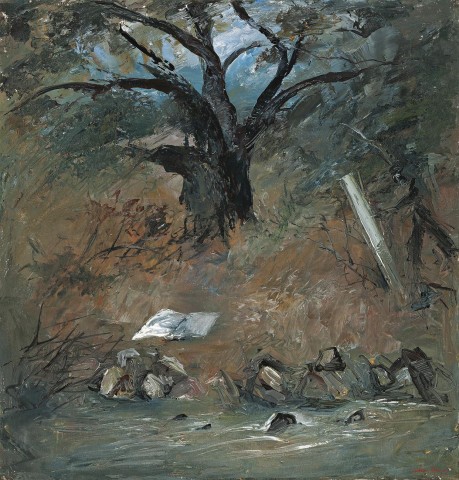ROCK AND LARGE TREE, 1973
ARTHUR BOYD
oil on canvas
114.0 x 119.0 cm
signed lower right: Arthur Boyd
bears inscription on frame verso: No. 2
Fischer Fine Art, London
Tolarno Galleries, Melbourne (label attached verso)
Alan and Nola Geddes, Sydney
Estate of Nola Geddes, Sydney
Arthur Boyd: Recent Paintings, Fischer Fine Art, London, May – June 1973, cat. 22 (illus. in exhibition catalogue, p. 26)
For more than a decade after 1959, Arthur Boyd lived the expatriate life in Europe. Following an invitation from the Australian National University, he returned to Australia for a residency in 1971 during which he undertook the now-famed journey to the Shoalhaven River during a sweltering summer. On his return to England, he found himself inspired by the encounter, particularly of a landscape he subsequently described as being more ‘challenging, fierce, rugged (and) grander’1 than his more familiar Victoria. Working predominantly from his Suffolk studio, Boyd poured his energy into a large suite of paintings which would form the core of his forthcoming exhibition at Fischer Fine Art, London, in 1973. Here he displayed some 68 large paintings which followed a sequence of inter-related themes, and Rock and Large Tree, 1973, was a key work within the broader narrative.
Boyd was, for the most part, always an expressionist artist in his use of restless paint surfaces and subjects full of drama and incident. His was a visceral approach and it was quite common for him to discard his brushes and attack the paint physically using his bare hands as tools. In spite of such an elemental tactic, Boyd was also someone who understood acutely the various possibilities of his medium ever since his earliest studies with his grandfather Arthur Merric Boyd Snr, and through his close reading of Max Doerner’s The Materials of the Artist and their Use in Painting, first published in 1934. Through his years of expertise, Boyd knew just how far to push the surface thus allowing him ‘to dig deep into the subconscious, and have the ability to transpose these imaginary apparitions directly into paint’.2 Brush, trowel and hands all appear to have been utilised in Rock and Large Tree in which we see an urgent apparition of an artist working desperately at his easel to capture his vision of an – apparently – Antipodean landscape, in spite of the fact that ‘his (Suffolk) studio window opened on to a copse of spruce, larch and other trees’.3 In associated works from the series, a model is seen resting in this vale, reading whilst dipping her feet in a stream. In others, the book is companioned by a dog or, as here, lies abandoned in wait, suggesting ‘an altogether different frame of mind from the pictures in which the (depicted) artist is assaulting his canvas under an Australian sky’.4 The series culminates with the so-called ‘caged painter’ series, where Boyd presents the artist (a self-portrait?) tortured by his visions, tools, politics and very humanity; and Rock and Large Tree may be understood as one relatively calm mid-point as the artist collects his strength for the final howling visions.
Many of the works from the Fischer Fine Art exhibition are now included in major State collections, particularly the National Gallery of Australia which owns a sequence including: Kneeling Figure with Canvas and Black Can, 1973; Woman injecting a Rabbit, 1973; Figure in Rushes and Small Birds, 1972 – 73; and Figure in a Cave with a Smoking Book, 1973, the last one being a direct companion to the current work on offer.
1. Hoff, U., The Art of Arthur Boyd, Andre Deutsch, London, 1986, p. 486
2. Arthur Boyd and The Exile of Imagination - Paintings and drawings from the early 1970's, National Gallery of Australia, Canberra, 1999
3. Hoff, U., op. cit., p. 65
4. Melville, R., ‘A View of Arthur Boyd’, Arthur Boyd: Recent Paintings, Fischer Fine Art Limited, London, 1973, pp. 7 – 8
ANDREW GAYNOR
